Vous souhaitez disposer d’un espace sûr pour expérimenter avec votre site WordPress sans craindre de casser quelque chose sur votre site en direct ?
Déplacer votre site WordPress sur un serveur local sur votre ordinateur est la solution idéale, à notre avis, en particulier pour les développeurs, les concepteurs ou les débutants en matière de WordPress.
L’installation de WordPress sur votre ordinateur (serveur local) vous permet d’apprendre facilement à utiliser WordPress et de tester des choses. Lorsque vous déplacez un site WordPress en direct sur un serveur local, cela vous permet d’expérimenter avec les mêmes données que votre site en direct.
Dans cet article, nous vous montrerons comment déplacer facilement un site WordPress en direct vers un serveur local.
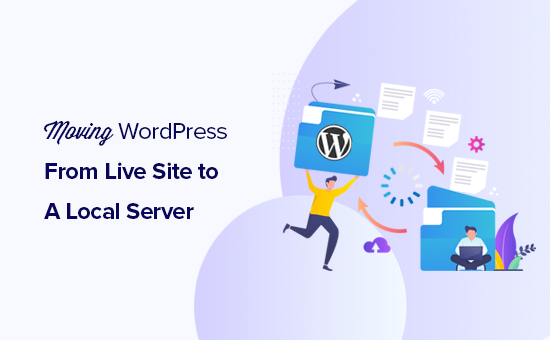
Pourquoi et qui voudrait déplacer un site WordPress en direct vers un serveur local ?
Si vous gérez un site WordPress depuis un certain temps, il se peut que vous souhaitiez tester de nouveaux thèmes ou une extension. Cependant, si vous le faites sur un site en direct, vos utilisateurs risquent d’avoir une mauvaise expérience.
Pour éviter cela, de nombreux utilisateurs créent une copie de leur site WordPress sur un serveur local pour tester de nouveaux thèmes, des extensions, ou faire des essais de développement.
Cela vous permet de configurer votre thème avec tout votre contenu et de tester toutes les fonctionnalités sans craindre de casser votre site. De nombreux utilisateurs copient leur site sur un serveur local afin de mettre en pratique leurs compétences en matière de WordPress et de codage avec les données réelles du site.
Même si vous pouvez effectuer tous les tests avec un contenu fictif dans WordPress, les données d’un site réel vous donnent une meilleure représentation visuelle de la façon dont ces changements apparaîtront sur votre site direct.
Préparation du transfert d’un site local vers un serveur local
Tout d’abord, vous devez vous assurer de toujours sauvegarder votre site WordPress. Il existe plusieurs excellentes extensions de sauvegarde WordPress que vous pouvez utiliser.
Deuxièmement, vous devez installer un environnement de serveur local sur votre ordinateur. Vous pouvez utiliser WAMP pour Windows et MAMP pour Mac. Une fois l’environnement installé, vous devez créer une nouvelle base de données à l’aide de phpMyAdmin.
Il suffit de visiter l’URL suivante dans votre navigateur pour lancer phpMyAdmin.
http://localhost/phpmyadmin/
http://localhost:8080/phpmyadmin/
A partir de là, vous devez cliquer sur l’onglet “Bases de données” et créer une nouvelle base de données. Vous aurez besoin de cette base de données pour décompresser ultérieurement les données de votre site en direct.

Vous êtes maintenant prêt à déplacer votre site WordPress en direct vers un serveur local.
Méthode 1. Déplacer un site WordPress En direct vers un serveur local à l’aide d’une extension
Cette méthode est plus simple et recommandée pour tous les utilisateurs.
La première chose à faire est d’installer et d’activer l’extension Duplicator. Pour plus de détails, consultez notre guide pas à pas sur l’installation d’une extension WordPress.
Duplicator vous permet de créer facilement un paquet de duplicata de l’ensemble de votre site. Il peut être utilisé pour déplacer votre site WordPress vers un nouvel emplacement, et peut également être utilisé comme une extension de sauvegarde.
Remarque : il existe une version gratuite de Duplicator avec laquelle vous pouvez commencer. Cependant, Duplicator Pro propose des sauvegardes illimitées et des fonctionnalités plus avancées.
Dès l’activation, rendez-vous dans Duplicator Pro ” Sauvegardes depuis votre barre latérale d’administration WordPress. Pour créer un nouveau package, vous devez cliquer sur le bouton ” Ajouter un nouveau “.
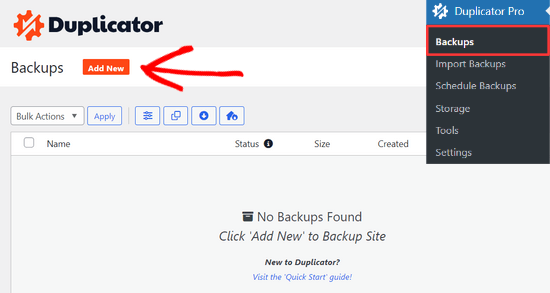
Duplicator lance alors l’assistant de sauvegarde.
Tout d’abord, vous devez saisir un nom pour votre paquet de sauvegarde. Vous pouvez également utiliser les identifiants dynamiques pour créer automatiquement un format de nom comme la date et le titre de votre site.

Développez ensuite la section “Stockage” et choisissez un emplacement de stockage.
Pour ce tutoriel, nous utiliserons l’emplacement par défaut. Vous pouvez cliquer sur le lien “Ajouter un stockage” pour ajouter un nouvel emplacement, comme Dropbox ou Google Drive, si vous le souhaitez.
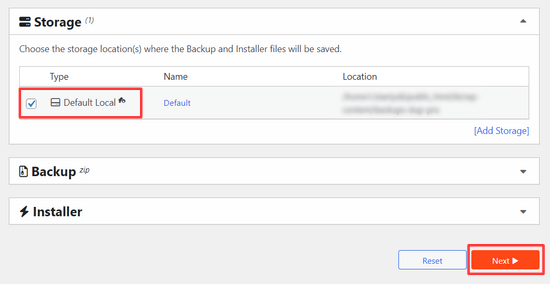
Cliquez sur le bouton “Suivant” pour continuer.
L’extension analysera ensuite votre site et effectuera des vérifications en arrière-plan. Il vous présentera ensuite un récapitulatif de ces vérifications.
Si tout semble correct, cliquez sur le bouton“Créer une sauvegarde” pour continuer.
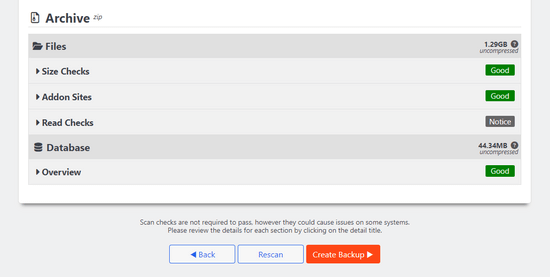
Duplicator va maintenant créer le paquet de votre site.
Une fois l’opération terminée, vous verrez apparaître un fichier d’archive zip contenant toutes les données de votre site, ainsi qu’un fichier d’installation. Vous devez télécharger les deux fichiers sur votre ordinateur.
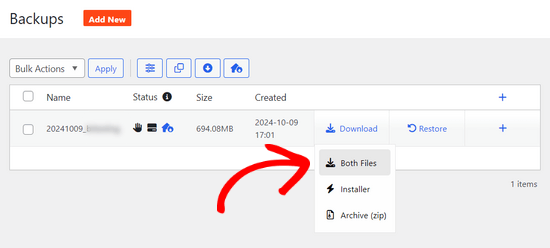
Vous êtes maintenant prêt à décompresser et à installer ces fichiers sur votre serveur local.
Tout d’abord, vous devez créer un nouveau dossier dans le dossier racine de votre serveur local. Il s’agit du dossier dans lequel votre serveur local stocke tous les sites web.
Par exemple, si vous utilisez MAMP, il s’agira du dossier /Applications/MAMP/htdocs/. Si vous utilisez WAMP, il s’agira du dossier C:\wamp\www\.
Dans ce dossier, vous pouvez créer de nouveaux dossiers pour chaque nouveau site que vous souhaitez importer ou créer sur votre serveur local.
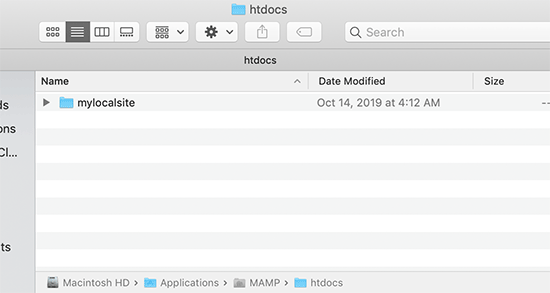
Ensuite, vous devez ouvrir le dossier que vous avez créé pour votre site local, puis copier et coller le fichier zip de l’archive et le programme d’installation que vous avez téléchargé plus tôt.
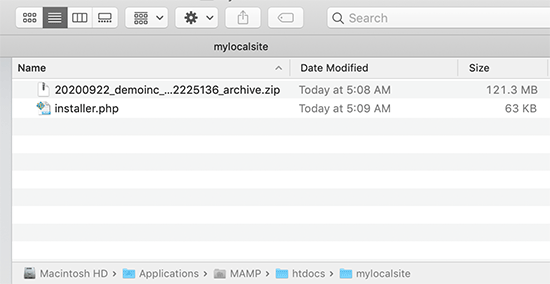
Pour lancer l’installation, vous devez ouvrir le script installer.php dans votre navigateur web.
Par exemple, si vous avez collé les deux fichiers dans le dossier /mylocalsite/, vous y accéderez dans votre navigateur en visitant http://localhost/mylocalsite/installer.php.
Le script d’installation de Duplicator s’affiche alors comme suit :
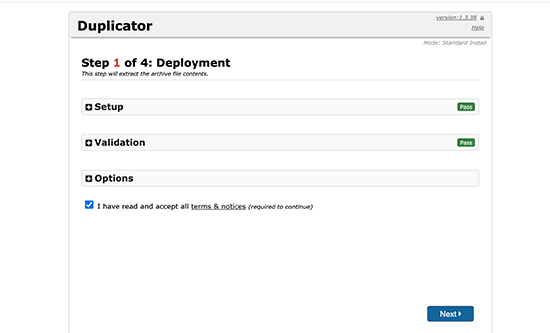
Cliquez sur le bouton “Suivant” pour continuer.
Duplicator va maintenant décompresser le fichier zip de l’archive et vous demandera de saisir les informations relatives à la base de données de votre site local. Il s’agit de la base de données que vous avez créée précédemment.
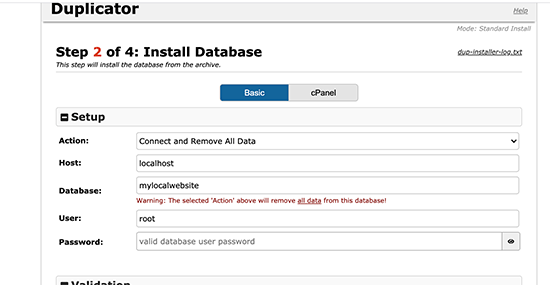
Le nom du serveur est presque toujours localhost et le nom d’utilisateur est root. Dans la plupart des cas, l’installation de votre serveur local ne prévoit pas de mot de passe pour root, vous pouvez donc laisser ce champ vide.
En bas de la page, vous verrez un bouton “Tester la base de données” que vous pouvez utiliser pour vous assurer que les informations de votre base de données sont correctes.
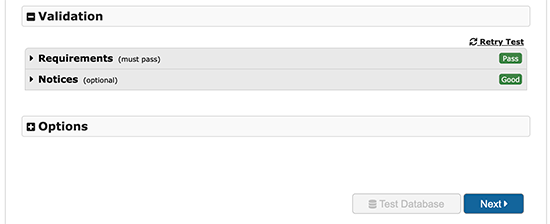
Si tout semble correct, cliquez sur le bouton “Suivant” pour continuer.
Duplicator va maintenant importer votre base de données WordPress. Ensuite, il vous demandera de revérifier les informations du nouveau site qu’il a détecté automatiquement.
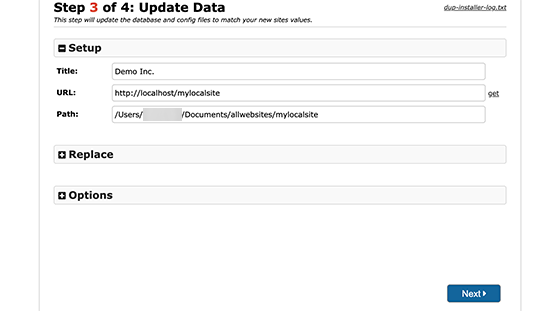
Cliquez sur le bouton “Suivant” pour continuer.
Duplicator va maintenant terminer l’installation et vous montrera un bouton pour vous connecter à votre site local. Vous utiliserez le même nom d’utilisateur et le même mot de passe WordPress que ceux que vous utilisez sur votre site En direct.
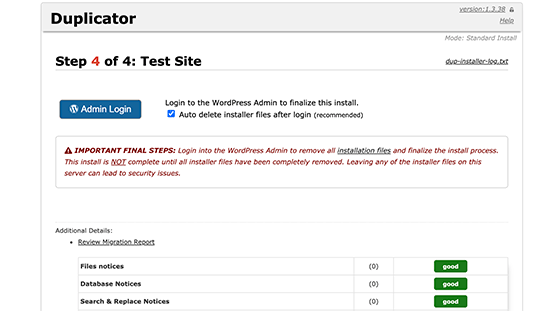
C’est tout, vous avez réussi à déplacer votre site direct vers le serveur local.
Méthode 2. Déplacer manuellement un site WordPress en direct vers un serveur local
Si l’extension ne fonctionne pas, vous pouvez toujours déplacer manuellement votre site en direct vers un serveur local. La première chose à faire est de sauvegarder manuellement votre site à partir de votre compte d’hébergement WordPress.
Étape par étape. Exporter la base de données WordPress de votre site direct
Pour exporter la base de données WordPress de votre site en direct, vous devez vous connecter à votre tableau de bord cPanel et cliquer sur phpMyAdmin.
Note : Nous montrons des captures d’écran du tableau de bord de Bluehost.
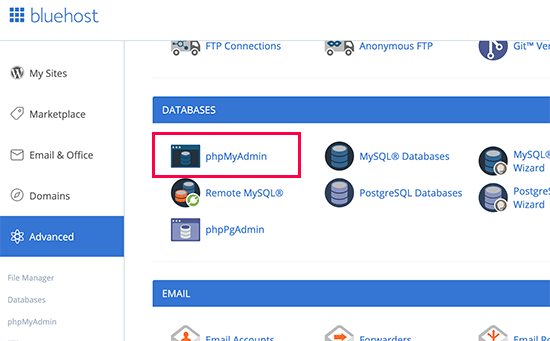
Dans phpMyAdmin, vous devez sélectionner la base de données que vous souhaitez exporter, puis cliquer sur l’onglet d’exportation en haut.
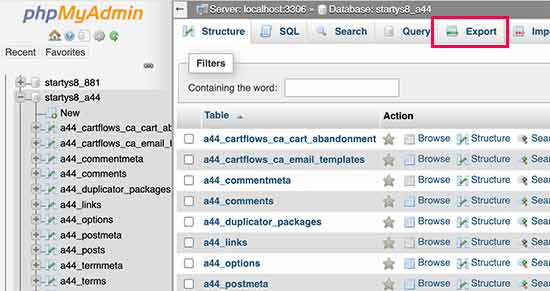
phpMyAdmin vous demandera alors de choisir une méthode d’exportation rapide ou personnalisée. Nous vous recommandons d’utiliser la méthode personnalisée et de choisir zip comme méthode de compression.
Il arrive que des extensions WordPress créent leurs propres tables à l’intérieur de votre base de données WordPress. Si vous n’utilisez plus cette extension, la méthode personnalisée vous permet d’exclure ces tables.
Laissez les autres options telles quelles et cliquez sur le bouton “Go” pour télécharger la sauvegarde de votre base de données au format zip.
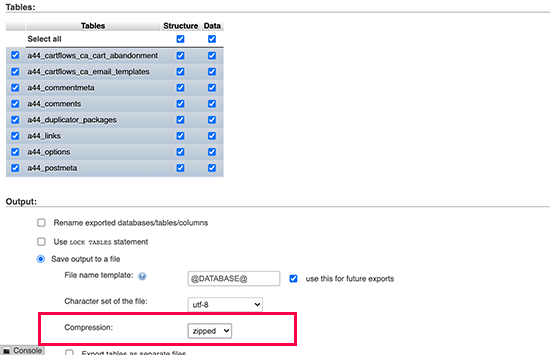
phpMyAdmin va maintenant télécharger le fichier de votre base de données. Pour plus de détails, consultez notre tutoriel sur la sauvegarde manuelle de votre base de données WordPress.
Étape par étape. Téléchargez tous vos fichiers WordPress
L’étape suivante consiste à télécharger vos fichiers WordPress. Pour ce faire, vous devez vous connecter à votre site WordPress à l’aide d’un client FTP.
Une fois connecté, sélectionnez tous vos fichiers WordPress et téléchargez-les sur votre ordinateur.
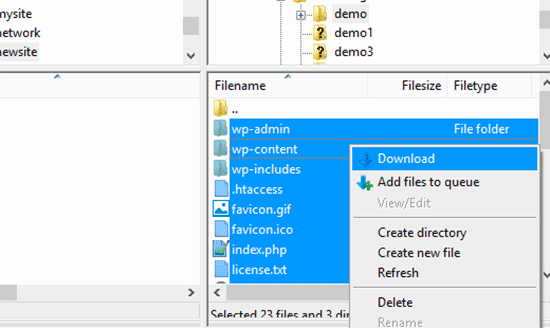
Étape par étape. Importez vos fichiers WordPress et votre base de données sur le serveur local
Après avoir téléchargé vos fichiers WordPress, vous devez créer un dossier sur votre serveur local où vous souhaitez importer le site local.
Si vous utilisez WAMP, vous devez créer un dossier dans le dossier C:³wamp³www³ pour votre site local. Les utilisateurs de MAMP devront créer un dossier dans le dossier /Applications/MAMP/htdocs/.
Ensuite, il suffit de copier et de coller vos fichiers WordPress dans le nouveau dossier.
Ensuite, vous devez importer votre base de données WordPress. Ouvrez simplement phpMyAdmin sur votre serveur local en visitant l’URL suivante :
http://localhost/phpmyadmin/
Comme vous avez déjà créé la base de données précédemment, vous devez maintenant la sélectionner et cliquer sur l’onglet “Importer” en haut de la page.
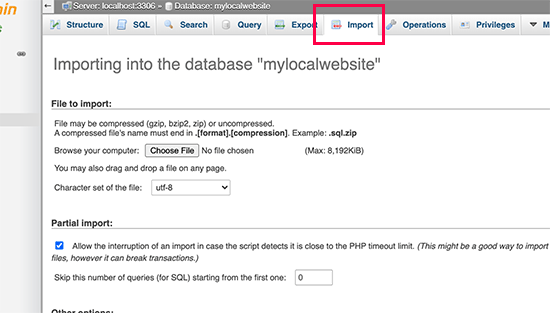
Cliquez sur le bouton ‘Choose File’ pour sélectionner et téléverser le fichier d’exportation de la base de données que vous avez téléchargé à la première étape. Cliquez ensuite sur le bouton “Go” en bas de la page.
phpMyAdmin va maintenant décompresser et importer votre base de données WordPress.
Maintenant que votre base de données est prête, vous devez mettre à jour les URLs de votre base de données WordPress qui font référence à votre site en direct.
Vous pouvez le faire en lançant une requête SQL dans phpMyAdmin. Assurez-vous d’avoir sélectionné la base de données de votre site local, puis cliquez sur SQL.
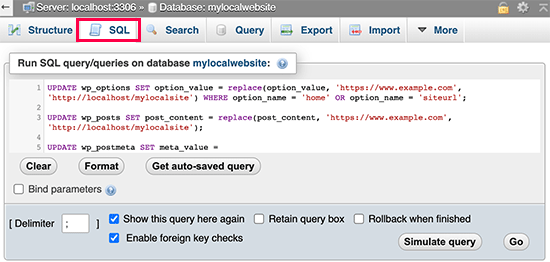
Dans l’écran SQL de phpMyAdmin, copiez et collez ce code, en veillant à remplacer exemple.com par l’URL de votre site direct et http://localhost/mylocalsite par l’URL du serveur local de votre site.
UPDATE wp_options SET option_value = replace(option_value,'https://www.example.com','http://localhost/mylocalsite') WHERE option_name ='home'OR option_name ='siteurl';UPDATE wp_posts SET post_content = replace(post_content,'https://www.example.com','http://localhost/mylocalsite');UPDATE wp_postmeta SET meta_value = replace(meta_value,'https://www.example.com','http://localhost/mylocalsite');
Cette requête remplacera les références à l’URL de votre site direct à partir de la base de données et la remplacera par l’URL de l’hôte local.
Étape par étape. Mettre à jour le fichier wp-config.php
La dernière étape consiste à mettre à jour le fichier wp-config.php de votre site local. Ce fichier contient les paramètres de WordPress, y compris la façon de se connecter à votre base de données WordPress.
Allez simplement dans le dossier où vous avez installé WordPress sur votre serveur local, puis ouvrez le fichier wp-config.php dans un éditeur de texte comme le Bloc-notes.
Remplacez le nom de la base de données par celui que vous avez créé dans phpMyAdmin sur votre hôte local.
Ensuite, remplacez le nom d’utilisateur de la base de données par votre nom d’utilisateur MySQL local, généralement root. Si vous avez défini un mot de passe pour l’utilisateur MySQL root sur votre hôte local, saisissez-le. Sinon, laissez le champ vide et enregistrez vos modifications.
/** The name of the database for WordPress */define('DB_NAME','database_name_here');/** MySQL database username */define('DB_USER','username_here');/** MySQL database password */define('DB_PASSWORD','password_here');
Vous pouvez maintenant visiter votre site local dans une fenêtre de navigateur en saisissant l’URL comme suit :
http://localhost/mylocalsite/
Remplacez ‘mylocalsite’ par le nom du dossier dans lequel vous avez copié vos fichiers WordPress.
C’est tout, votre site WordPress direct est maintenant copié sur votre serveur local.
Nous espérons que cet article vous a aidé à apprendre comment déplacer facilement un site WordPress live vers un serveur local. Vous pouvez également consulter notre guide sur la façon de créer facilement un site de mise en scène pour WordPress à des fins de test, ou comment déplacer un site WordPress d’un serveur local vers un site direct.
Si vous avez aimé cet article, veuillez alors vous abonner à notre chaîne YouTube pour obtenir des tutoriels vidéo sur WordPress. Vous pouvez également nous trouver sur Twitter et Facebook.





Reese
Hello,
I am receiving an error when reaching this step:
“Now that your database is all set up, you need to update the URLs inside your WordPress database referencing to your live site. You can do this by running an SQL query in phpMyAdmin. Make sure you have selected your local site’s database and then click on SQL. In phpMyAdmin’s SQL screen copy and paste this code, make sure that you replace example.com with your live site’s URL and localhost/test-site with the local server URL of your site. ”
The error is:
#1146 – Table ‘rpd.wp_options’ doesn’t exist
Please advise, thank you!
Martin
Thanks for all of your hard work. I’m a beginning web developer and your site is incredibly helpful.
I have looked at both of your articles about migrating from local to live and vice versa. I built a WordPress site locally and used it to replace an existing HTML site. I then made changes to the live site, and I’m not quite sure how to go about “syncing” them again. What would you suggest?
WPBeginner Support
Hi Martin,
Please take a look at our guide on setting up a staging environment.
Admin
James
Thank you for the article, however i have still been having problems.
One thing i don’t understand, is that you start of by recommending using backupbuddy (which i have been using to backup my sites) but then suddenly say to use this duplicator plugin.
I have my full backup (with db) zip of my wordpress site which i created with backupbuddy and have unzipped it into its own folder in the “www” folder in wamp.
I successfully create a new DB in PhpMyAdmin and then successfully imported my website db into it. I have also changed the config.php db name and password.
However on the next step, trying to change the urls it comes back with:
#1146 – Table ‘zexico.wp_options’ doesn’t exist
#1146 – Table ‘zexico.wp_posts’ doesn’t exist
#1146 – Table ‘zexico.wp_postmeta’ doesn’t exist
What have i done wrong?
thank you
Ozi Diptongo
Hi. I’m getting the same error. Were you able to fix it ? Than you !
Nina Chang
Following on from my earlier comment – I fixed the problem! For some reason the duplicator plugin wasn’t copying across all of my database tables, which was causing the first round of issues – I sorted that by switching to the manual method. Then when I was running the queries in mysql I didn’t realise at first that I had to amend the names of the database tables as well (i.e. was just pasting wp_options when I needed to adapt that) – I’m not sure if this is normal as your lines of code only highlight the urls as needing to be corrected? THEN I had to deal with my strange wp-config.php file that had all the ‘database’, ‘host’, ‘username’ fields already filled in – after trying both options it only worked when I deleted the data that wordpress had already filled in and replaced it with the localhost data as directed. I don’t understand why my wp-config file had its fields already populated but then I’m a complete newbie to all this so I’m bound to have missed/misunderstood lots. Anyway – thanks again for the tutorial as it did FINALLY get me there!
Nina Chang
Hi there,
Thanks for the tutorial. I’ve attempted to migrate my site with duplicator and it seems to work except I then can’t log-in to my locally hosted site – it doesn’t recognise my username at all. After the duplicator installed my files I had two config.php files – one config-sample.php and one config.php, and also two htaccess files – one .htaccess and one ORIG – could these doubled-up files have something to do with my login issues? I’ve tried every variation of deleting one of each pair, and I’ve also tried replacing my wp-login file and deleting plugins as I read elsewhere this might help, but nothing has worked. I redid the entire process from packaging and still no luck! I’ve also tried manually but got stuck at the mysql query updates. Do you have any idea where I’ve gone wrong??
Many thanks!
Nina
Susan Taunton
I can’t tell you how grateful I am for this info. I have put an unbelievable amount of time into trying to get a live site onto my local server to no avail — and then I found your post today. Used the Duplicator and it WORKED!
THANK YOU!!!!!!!!! :-))
Editorial Staff
You’re very welcome Susan
Admin
Dilip Pradhan
I have copied website from hosting domain to local host. everything is fine but all links of menu and all are redirected to
how to solve it
Byron Allen
hi ,
I had the same problem and just found the solution. I’m sure you’ve solved it by now but this might help others down the track.
in WordPress admin area go to settings-> permalinks. Choose Post name.
Your problems should be solved.
John Payne
Thanks for all the excellent advice you give- it’s a wonderful service to the WordPress community.
I’ve begun using the All-in-1 WP Migration plugin to easily backup my site , and later migrate it if necessary.
It would also be good to be able to make changes to the sites on my own computer, checking them out before uploading updated files.
I’, installing XAMPP on my computer. Is there an easy way I can use my All-in-1 WP Migration backup files with this?
Any advice will be much appreciated.
WPBeginner Support
Hi John,
Sorry but we haven’t tested this plugin. Please try contacting the plugin developers.
Admin
Andres
Great tutorial. Its important to mention that you need to delete the HTACCESS File in order to this to work.
Thanks
James orr
From local site?
Siddhartha
Yes from the local site folder. I did that, and my site started working. However there are many other problems that I am facing even now. Like my category links are not working at all.
lohith
cool super clean tutorial, got mine to work without any issues.
Gokiko
Hi WPbeginner,
I have followed all the instructions for manual moving. But I’m getting a “Oops! That page can’t be found.” error on the mainpage, none of the content can be viewed. And all the links in my localhost site direct to my online website.
It seems only the the main structure of my site(theme, menus etc.) has been moved but all the rest is lost.
WPBeginner Support
Is this error shown with your WordPress theme or on a blank white page? If it is shown on a blank white page, then this probably means that your WordPress site is not installed on the URL you are trying.
Admin
Gokiko
It shows on my WordPress theme. It also shows all my menus and content categories. But all the links take to the original websites address. Here is a screenshot if it’s gonna help:
WPBeginner Support
Try refreshing your site’s permalink structure. Go to Settings » Permalinks page and click on the save changes button without making any changes.
Juan
I have the exact same issue, but I can not log-in into my localhost using wp-admin or wp-login as it takes me to the live-site domain.
Is there another way to login to my localhost/dev-site area to make this change? thanks in advance!
Jason Hess
Dear WPBeginner,
First of all, Thank you for all you do in the WP community, my question is hopefully a pretty simple one. (Famous last words huh?) Currently I use CLEF to log in to my “Live Site”. When I move my Live site to my Local server, will this create any issues when attempting to log in to the local site once the move has been completed? Or do I need to create a new log in PW for my site via the Dashboard in my Live site before making the move to a Local environment or will CLEF still continue to work on my “Local Server”?
Also, do you all have any thoughts on using CLEF to log in? I’ve been using WP on and off for about 2 years and just want to get your opinion on CLEF.
Thank you very much in advance! You guys rock! After I get my site up and running you can bet I’ll promote your site to everyone I know. I’ve learned so much already from your site and I’ve only been a member for 2 almost 3 months now.
Have a great Day,
Jason Hess
WPBeginner Support
You can disable Clef at anytime once you have transferred your site to local server.
Admin
Mohd Amir
I forgot the password of filezilla, so I couldn’t download all the file of live site. I have backup of live site wp_content only. What can I do now for local server.
maarja
Hi,
Thank You for Your helpful directions.After a long while, I finally got the live page to my localhost with the plugin BUT for some reason, the content pages are not found on the server-all the information, texts etc is there in the back-office but aren’t shown in the front office except for the front page.
Do You have any idea where/why the problem might occur?
Thank You in advance,
Maarja
WPBeginner Support
Try following the steps in our beginner’s guide to troubleshooting WordPress errors.
Admin
Yellow Canary
Thank you very much I have done it manually… from a live server to localhost. With your instructions I have managed this for the first time. And I even know now how to do a SQL query in phpMyAdmin. I feel like a real pro!
I have done it manually… from a live server to localhost. With your instructions I have managed this for the first time. And I even know now how to do a SQL query in phpMyAdmin. I feel like a real pro!
amna
Hi,
i followed all the steps but i am getting internal server error .
I am confused in one step , after downloading the live site through filezill from godaddy host. i replace the wordpress folder with my live site folder i.e.
C:/users/amna/wamp/www/wordpress/old folders
with C:/users/amna/wamp/www/wordpress/mywebsite new folders
please help i am a beginner
Debenkumar Naorem
Hi WEBBIGINNER SUPPORT, I followed the instruction for manual, it works very fine. Thanks for such intructions, I’ve been looking for this. Thanks again.
WPBeginner Support
Hey Debenkumar, you are welcome. Don’t forget to join us Facebook for more WordPress tips and tutorials.
Admin
Manish
Hey! Thanks for the post.
I followed manual instruction and replaced my site URL with localhost/name of blog . The problem I am facing is, no images are being loaded in my blog. All the uploaded images are there in upload folder. The text is absolutely fine. The images url have changed to localhost but they are not showing up.
Could you please help me out in this?
deepthi
hi, i followed the manual procedure to check my wordpress website in localhost using xampp, i hav changed the site URL, home and the wp-posts and wp-postmeta. the problem is my home page loading fine in localhost. but when i go the pages in the menu the following error is coming.
Object not found!
The requested URL was not found on this server. The link on the referring page seems to be wrong or outdated. Please inform the author of that page about the error.
If you think this is a server error, please contact the webmaster.
Error 404
localhost
Apache/2.4.10 (Win32) OpenSSL/1.0.1i PHP/5.5.15
i logged into dashboard and can see all of the page content in the editing section, but from there also, when i try to view the page its reporting the same error.
the url path it is taking is my updatedURL only,
please reply with the solution
WPBeginner Support
Go to Settings » Permalinks page and click on the ‘Save Changes’ button to update your permalinks.
Admin
Joshua S.
Can I hug you? Can I love you forever?
I was having the same issue. I did everything correct, except the homepage would load , but all the other page links seemed to be broken (it just displayed an unstyled layout of my localhost information).
But going into Settings>Permalinks>Save Changes reset my links and now I can access my different pages, even the new pages that I create since moving my site to the local host.
LIKE!
WPBeginner Support
Thanks Joshua, we are glad you found it helpful. You may also want to subscribe to our YouTube Channel for WordPress video tutorials.
Peter
After following the instructions to manually move the site, the home page displayed fine on localhost but none of the links worked. The page below said to “Go to settings/permalinks in the wordpress dashboard and update permalinks by clicking twice on save changes.” That fixed it.
Mohd Hasan
I followed your steps , but only home page works fine and none of the links are working . Give The requested URL /akhdir3/category/health/ was not found on this server.
Anes P A
Dear Author,
I tried your step. But problem is when loading a page the localhost refer online site and the Menu links point to the online web site. How it can solve ?
Please advise.
Thanks
Anes
Bhavana
I have manually done all the above mentioned steps . But I am not getting the actual site which I want.There comes all uninstalled plugins in admin panel and the theme is also uncustomized. Where I am going wrong?
Justin
I’m trying to follow your instructions for a manual move.
When trying to find/replace the live site’s address with my local host, SQL tells me there’s a syntax error.
#1064 – You have an error in your SQL syntax; check the manual that corresponds to your MariaDB server version for the right syntax to use near ‘)’ at line 1
Are you sure the code is correct?
Justin
Fixed my own problem….sort of.
For some reason all my tables begin with wplm instead of just wp (wp_options = wplm_options for example). So updating the code to look for the correct table name allowed the script to run without errors.
But….SQL reports “# MySQL returned an empty result set (i.e. zero rows)” and the values in the table didn’t get updated. I had to go in and update the links by hand. In my case this was only 2 values in wplm_options, but I could imagine some people will have a lot more links to check.
Still, I do have my site imported now, and dealing with local hosting is a notoriously confusing process.
Thanks for the clear and simple instructions!
Lloyd
The instructions for Duplicaor Installer begin with this line:
“Your local server site will need a new database, so you need to create a database on your local server using phpMyAdmin.”
Is creating a new database something simple like clicking a menu option, or is it so complex that it would require an extensive tutorial to explain?
When I explore phpMyAdmin on Xampp, the only thing I see that looks like a possibility is under the Databases tab where it says:
“Create database:
(X) No Privileges”
Is there an authorization problem, and if so where do I go to change that parameter?
I have two web sites on this local host that seem to function properly, so I have assumed that the local host is set up correctly.
Thanks for any help or suggestions,
Lloyd
Ashvani Kumar
I am following the Manual option but when i go to Import Database page in phpMyAdmin then the max size for database upload is (Max: 2,048KiB) but my database backup size is 710MB. How do i increase this limit so that i can upload the database?
Thanks
WPBeginner Support
You need to increase the file upload limit in PHP. See our guide on how to increase the maximum file upload size. and follow the php.ini method
Admin
Abdul Aleem Mohammed
Hi Ashvani,
you can change the max_upload_size in php.ini file in apache.
by default it will be 2 Mb, you can change it according to your convinience.
Thanks
Judy Williams
I am trying this using Duplicator. I have downloaded my site and the installer. I have created a database using phpMyAdmin and have got to the bit ‘you need to copy and paste the package and install file to an empty folder in your local server’s web directory’. I have no idea how to do this! I have Filezilla and XAMPP installed on my laptop. Is there a tutorial on how to create an empty folder in my local server’s web directory? I am stuck now. Thanks
WPBeginner Support
You can just go to the htdocs folder on your computer.
Admin
german
I’ve copied the files and database, when i try to access my localhost/test-site i get redirected to the dashboard. Any ideas why this could be happening?
miguel
thank you for the clear tutorial.
although i’ve done the opposite (from localhost to public server) i thought the reverse would be equally simple.
however, when it comes to connecting the database, i’m stumped. i’ve gone over the settings over and over without being able to connect.
i even got into some trouble and got locked out of the database but fortunately got that resolved.
in my config.php file i’ve changed the user to “root”, then set it to empty, used the user name from the public server and the same with the password. i have set the db name correctly to the localhost name.
i can’t guess what i need to do.
if you could give me a direction to look next, i’ll appreciate it greatly.
thank you for you labor of love. it’s great to see so many people with the knowledge helping us those who look for answers.
Daniel
Hi
I want to do this as well. Is this post written a few years back , still the approach to use or are the other plugins or post I should be looking at .
Daniel
Beatrix K.
Hi everyone,
Just wondering (please bare with me as I am new at this) – if I need to have have my local site to work with on two different devices, say my desktop and my laptop, is there a way for the changes I make on one device to be updated on the other device? I just want to know if it is possible to work from two different devices on the same project and not have to redo all of my changes. Thanks in advance for any insight
B
Muniba
I am confused in step related to Filezeila ,,, how i will download my wordpress site using Filezeila..??
german
download filezilla, establish a connection to your current host, productions site using filezilla. Once you have a connection you will be able to download the files to a local directory on your computer
Dee
So with CPanel, for instance, we’d use the IP associated, our CPanel user and pass, along with “21” as the port value? After establishing a connection with Cpanel host, how can I transfer the files to my localhost while keeping the live site as well? Essentially, how do I create a duplicate with having the same site at both hosts (one to experiment with and one that remains live)?
Dee
After successfully transferring files from remote to local, what is an easy way to bulk copy&paste (instead of manually one-by-one) the files to the local server where we want to install WordPress? I tried selecting all files to copy, but there is no copy function available. Please Help
assal0le
I want to copy my live wordpress site to my local wamp server, note moving it. My question is this will remove my live wordpress site if I follow this tutorial using duplicator plugin?
Thx
Diane Laidlaw
No it only copies it.
Ognatius Chironga
I thank you so much!
I found this article helpful.
I almost restarted creating my site.
Quy P
I have tested and tried a number of time. It does not work untill i delete the .htaccess file on local. Thank you.
Andres
Thanks very much.
Tobias
If you are running a network of sites you should also update the column domain URL’s in the table wp_blogs.
lorenzo
Thank for this useful tutorial. I have to move manually my wp site, but if I type in the browser “http://localhost/phpmyadmin/” it doesn’t appear myphpadmin. Maybe I have to install it? How?
Thank you very much…
Dave
In the wp-config.php file I also have to change the /**MySQL hostname */
/** MySQL hostname */
define(‘DB_HOST’, ‘localhost’);
set if for localhost
nicola
Hi,
i follow your step but the admin login is not visible…. error 404 not found. all the site is good in my local installation. how can i solve my problem?
abdelouahad
i did all the steps but i have always the error page i don’t know why some one can help me please
Paul Denver Sy
Thank you so much for this. It saved my almost a week of agony on running it on my local.
Shilling
Double checked all the steps and it all seems good, but I’m getting this error message when I go to the site on my local URL:
Google Chrome’s connection attempt to localhost was rejected. The website may be down, or your network may not be properly configured.
I don’t think the site is down. My local URL is auto flipping to http://localhost/wordpress-folder-name
when I think it should go to http://localhost:888/wordpress-folder-name
I’m hoping this is an obvious clue. I’m new at this and just have no idea.
Any insight would be much appreciated.
Ebert
This was the clearest tutorial I found which helped me to copy a site I started with iPage to my laptop under localhost. The database was not imported but created a new local copy of the server database. I copied the data tables into my new database and modified the sql commands to match the table names and everything ran smoothly.
I had to reuse the password I used on the live site with the local wordpress copy and I can now access and modify what I need to.
Thanks and you just got another new subscriber to this great site.
Also the post about BackWPup was very helpful as well. I tried to use Duplicator and it kept giving me error messages about permissions to create a backup folder on my machine. I used BackWPup and everything ran without a hitch. Thanks again!!
Eduardo Weidman Barijan
The manual process worked like a charm. Thank you.
Alessio
Hi guys,
I’m trying to config the localhost on my computer with linux mint.
i’ve already set up a new database, transferred the files with FTP to my local wordpress folder.
Now I imported the db, but when I give the query to change the webaddress with a local address, it will give me a message “# MySQL returned an empty result set (i.e. zero rows)”.
Now, if I type in the browser “localhost”, it will lead me to the online website…
what should I do?
thank you!
idriss
Hey Allesio,
Did you manage to solve this?
I have the same issue. How did you manage to solve it?
Thanks
Justin
Same problem here.
SQL is having trouble replacing the live site URL with the local host address.
Without the updates to the database, WP tries to connect to the live site instead of the local site.
Did either of you have any luck fixing this?
Sam
Go to your localhost phpmyadmin and the database you are using for the site. Click wp_options and edit the siteurl and home. Replace the live url with the: localhost/ your-folder-name-goes-here
That should do it.
Sam
Mike
The first step worked with me.
But how can I enter to localhost/test-site/wp-admin? It gives me an error message:
Internal Server Error
Wenke Adam
Updating the local site’s wp-config.php file might not be the last step in this procedure. I followed your instructions and after some trials the public site was working (first I had a typo in the SQL queries and nothing happened) but still I couldn’t access wp-admin.
The solution was to edit the wp_options table in the database. The first row had the wrong URL. I fixed this and finally everything was working fine, even the permalinks.
Thanks for all these very nice and clear tutorials!
Tim
I am reposting this because it seems to have disappeared (at least on my end). So I am sorry if it is a double post.
I am getting an error message when uploading the database. Any ideas?
Thanks
Tim
When I try to upload the database I get a Red Error Screen. I can send a screenshot of the error if you would like.
Thanks
WPBeginner Support
Sure, you can upload the screenshot to a cloud hosting service like dropbox and paste the link as a reply to this comment. We will then take a look and will try to help.
Admin
Ian Hyndman
All day I have been trying to do this change with no effect !
I even had to install word press again on my testing server. Was about to give up then I came across this. My other option was to manually copy and paste and install all the same plugins active on my host server to my testing server.
When i read your post i finished in 5 minutes :):)
Thank you for your tutorial, its just what I needed. !
Well Done
Alexandros
Two days i am trying to do this change alone with no effect !
When i read your post i finished in 5 minutes :):)
Thank you for everything !
Keep up the great work